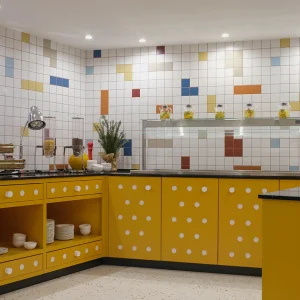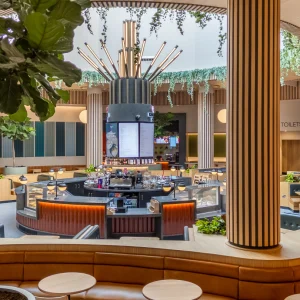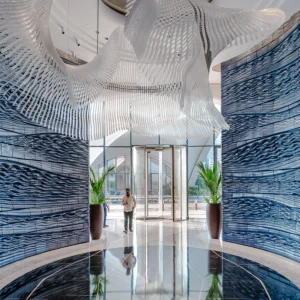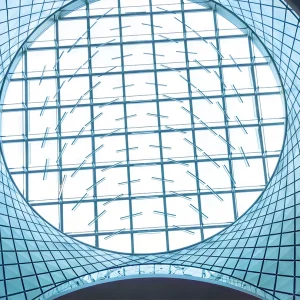
The first speaker was Dan Wood of New York-based WORKac. He explained that the New Holland 24-hour cultural quarter project is on a triangular island site deeply embedded in St Petersburg’s urban fabric, physically and historically. Peter the Great, who founded the city and gave it its Amsterdam-inspired canals (currently the subject of a fascinating Hermitage Amsterdam Hermitage exhibition ), built a small palace there. It subsequently became a naval centre, and the Russian Admiralty built eighteenth-century brick warehousing, a nineteenth century circular prison (fittingly, it will become a designer hotel), and later, an engineering basin. Wood explained that turning New Holland into a contemporary complex including art gallery and flats was ‘more a restoration program’, and that even the smell of the eighteenth century had been chemically recreated as part of the project. A new walkway will be weaved up high into the old buildings, and the only entirely new volume will an angular low-rise museum from which a balloon attraction will be tethered.
Hala Wardé, from Ateliers Jean Nouvel, had a very different situation at Saadiyat Island in Abu Dhabi – a tabula rasa of sand. The Nouvel-designed and Louvre-branded museum is already under construction there, in a gargantuan masterplan that also includes a new Arts Centre by Zaha Hadid, Guggenheim by Frank Gehry and Maritime Museum by Tadeo Ando. She explained that after landing by helicoptor there, Nouvel had a vision of a microcity under a roof with an access canal. The galleries and other rooms would each occupy a differently-sized box (one actually designed by Foster, Wardé revealed) seperate from its neighbours, ‘like an Arab city’, all shaded by the 180m-diameter dome whose perforations give a nod to Islamic screens and, as she expained, ‘give a rain of light’. There’s a lot of light in the UAE, and when modelling the holes, she revealed that when they ‘were only 3% but we realised it was too much’.
Foster+Partners’ Spencer de Grey gave an account of the masterplan of West Kowloon Cutural District, enhanced by his particularly distinguished voice and Corbusian glasses. The 40-hectare site isn’t the most people-friendly, cut into by a huge motorway tunnel mouth and in the shadow of the Farrel-masterplanned West Kowloon quarter that has become a fortress-like enclosure of skyscrapers with trains, but on the other side there are amazing vistas across Victoria Harbour to Hong Kong island with its far better skyscrapers and Peak. The waterside will be an informal park. 17 new venues will be built, mainly for performance but also including the M+ Museum (the architectural competition for which includes Renzo Piano, SANAA and Herzog & de Meuron) . ‘We’re trying to avoid the cultural ghetto’, announced de Grey. The practise drew inspiration from how 17 venues occupy the same area in London’s West End yet are so deeply integrated into the urban fabric, most are almost lost in it, and their research included a visual analysis of nearby Nathan Road (24% billboards, 13% sky, etc) which exemplifies Kowloon’s density and vibrancy. The urban grain around there is the basis of plots along the new zone’s central spine called The Avenue. Oh, and you’ll be to catch a high-speed train to Beijing from there.
Aric Chen, already appointed design and architecture curator at M+, and Mariona Barber of the Moscow-based Iris Foundation (consultants to New Holland Island), joined the post-presentation discussion. When Heathcote gently suggested that ‘all these projects take place in countries were there are issues’, Chen was the first to concur: Mainland China is ‘the elephant in the room’. The West Kowloon Cultural District is a response to that, he suggested. ‘Hong Kong is caught in a bit of an identity crisis’, he said, adding that ‘some are expecting us to become a museum of Hong Kong identity’.
Barber was less commital about political things in St Petersburg, the springboard for history-changing supremos, the latest of whom is Putin. She did offer that ‘there’s a big surplus of beautiful buildings’, indeed the city itself is a museum. ‘We’re trying to bank on the culture’, she said, to which Dan Wood added that there’s ‘a lack of contemporary art’ there. (Clearly he has overlooked Chto Delat , but Blueprint hasn’t!)
It’s interesting that all of the projects discussed involve the integration of urban context with the great museum/gallery. None of these projects are a single stand-alone signature building. Nouvel’s design may be the nearest to a trophy building, but the vision is unique and brilliant- deconstructing the physical unity of the museum to evoke urban patterns, and washing it with dappled light (which, although filtered very differently, nevertheless reminds one of the watery light effects in their Bains des Docks in le Havre). Even the idea of a pure cultural quarter, distinct from quarters of residential, office, retail etc, is outdated. The Foster Plan spelt this out, leapfrogging the reality on the ground at places like the South Bank where the trend is to bring other activities into the mix. As Barber pointed out, the museum nowadays is ‘about now. Lots of things converge, it’s not just history anymore’.
Now assured that the Bilbao Effect is yesterday’s news, many of the audience headed to the tube at Southwark, passing the massive construction site of Herzog & de Meuron’s 64m-high sculptural Tate Modern extension without batting an eyelid..
If You Build It, Will They Come? New Cultural Projects in Abu Dhabi, Hong Kong and St. Petersburg
15 April 2012
Tate Modern, London
Herbert Wright





